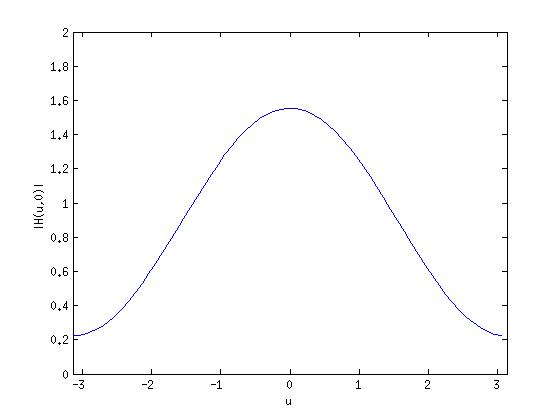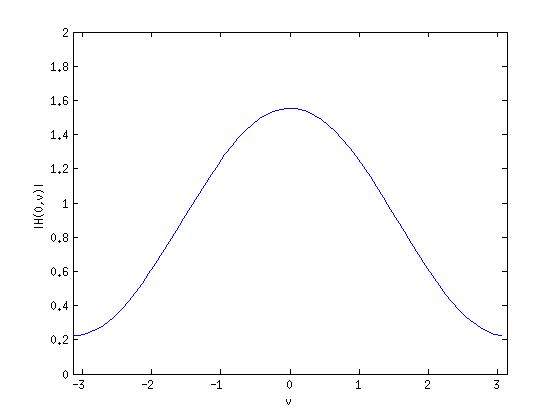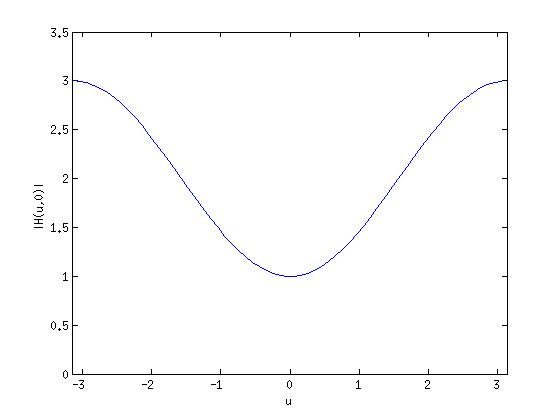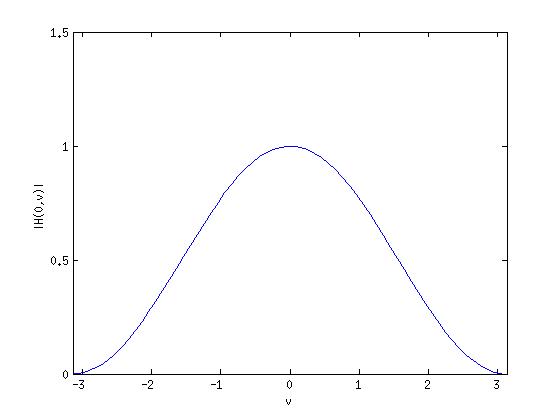| Line 141: | Line 141: | ||
\end{array}</math> | \end{array}</math> | ||
| + | |||
---- | ---- | ||
Revision as of 18:51, 1 December 2014
Contents
Homework 11, ECE438, Fall 2014, Prof. Boutin
Question 1
Consider the following filter:
$ h[m,n]: \begin{array}{cccc} & m=-1 & m=0 & m=1 \\ n=1&\frac{1}{16} & \frac{2}{16} & \frac{1}{16} \\ n=0&\frac{2}{16} & \frac{4}{16} & \frac{2}{16} \\ n=-1&\frac{1}{16} & \frac{2}{16} & \frac{1}{16} \end{array} $
a) Write a difference equation that can be used to implement this filter.
b) Is this filter separable? Answer yes/no and justify your answer.
c) Compute the DSFT H(u,v) of this filter. Sketch the plot of H(u,0). Sketch the plot of H(0,v). What are the characteristics of this filter (low-pass, band-pass, or high-pass)?
d) What is the output image when this filter is applied to the following image (using symmetric boundary conditions)?
$ g[m,n]: \begin{array}{ccccccccccc} 0 & 0 & 0 & 0 & 0 & 0 & 0 & 0 & 0 & 0 & 0\\ 0 & 0 & 0 & 0 & 0 & 0 & 0 & 0 & 0 & 0 & 0\\ 0 & 0 & 0 & 0 & 0 & 0 & 0 & 0 & 0 & 0 & 0\\ 0 & 0 & 0 & 0 & 0 & 0 & 0 & 0 & 0 & 0 & 0\\ 0 & 1 & 1 & 1 & 1 & 1 & 1 & 1 & 1 & 1 & 0\\ 0 & 1 & 1 & 1 & 1 & 1 & 1 & 1 & 1 & 1 & 0\\ 0 & 1 & 1 & 1 & 1 & 1 & 1 & 1 & 1 & 1 & 0\\ 0 & 1 & 1 & 1 & 1 & 1 & 1 & 1 & 1 & 1 & 0\\ 0 & 1 & 1 & 1 & 1 & 1 & 1 & 1 & 1 & 1 & 0\\ 0 & 1 & 1 & 1 & 1 & 1 & 1 & 1 & 1 & 1 & 0\\ 0 & 0 & 0 & 0 & 0 & 0 & 0 & 0 & 0 & 0 & 0\\ \end{array} $
Question 2
Consider the following filter:
$ h[m,n]: \begin{array}{cccc} & m=-1 & m=0 & m=1 \\ n=1&-\frac{1}{9} & -\frac{1}{9} & -\frac{1}{9} \\ n=0&-\frac{1}{9} & -\frac{8}{9} & -\frac{1}{9} \\ n=-1&-\frac{1}{9} &- \frac{1}{9} & -\frac{1}{9} \end{array} $
a) Write a difference equation that can be used to implement this filter.
$ \begin{align} y[m,n] =& -\frac{1}{9}(x[m+1,n-1] + x[m,n-1] + x[m-1,n-1] \\ & + x[m+1,n] + 8 x[m,n] + x[m-1,n] \\ & + x[m+1,n+1] + x[m,n+1] + x[m-1,n+1]) \end{align} $
b) Is this filter separable? Answer yes/no and justify your answer.
No. The coefficient matrix of h[m,n] cannot be decomposed to two vectors.
c) Compute the DSFT H(u,v) of this filter. Sketch the plot of H(u,0). Sketch the plot of H(0,v). What are the characteristics of this filter (low-pass, band-pass, or high-pass)?
$ \begin{align} H(\mu, \nu) = DTFT\{h[m,n]\} =& -\frac{1}{9} (e^{j(\mu-\nu)} + e^{j(-\nu)} + e^{j(-\mu-\nu)} \\ & + e^{j(\mu)} + 8 e^{(0)} + e^{j(-\mu)} \\ & + e^{j(\mu+\nu)} + e^{j(\nu)} + e^{j(-\mu+\nu)} ) \end{align} $
$ \begin{align} H(\mu, 0) =& -\frac{1}{9}( e^{j\mu} + e^{-j\nu} \\ & + e^{j\mu} + 8 + e^{-j\nu} \\ & + e^{j\mu} + e^{-j\nu} ) \\ =& -\frac{1}{9}(8+6cos{\mu}) \end{align} $
$ \begin{align} H(0, \nu) =& -\frac{1}{9} (e^{-j\nu} + e^{-j\nu} + e^{-j\nu} \\ & + 8 \\ & + e^{j\nu} + e^{j\nu} + e^{j\nu}) \\ =& -\frac{1}{9}(8+6cos{\mu}) \end{align} $
$ |H(\mu, 0)| = \frac{1}{9}(8+6cos{\mu}) $
So, $ H(\mu, 0) $ is a high-pass filter.
$ |H(0, \nu)| = \frac{1}{9}(8+6cos{\nu}) $
So, $ H(0, \nu) $ is a high-pass filter.
d) What is the output image when this filter is applied to the following image (using symmetric boundary conditions)?
$ g[m,n]: \begin{array}{ccccccccccc} 0 & 0 & 0 & 0 & 0 & 0 & 0 & 0 & 0 & 0 & 0\\ 0 & 0 & 0 & 0 & 0 & 0 & 0 & 0 & 0 & 0 & 0\\ 0 & 0 & 0 & 0 & 0 & 0 & 0 & 0 & 0 & 0 & 0\\ 0 & 0 & 0 & 0 & 0 & 0 & 0 & 0 & 0 & 0 & 0\\ 0 & 1 & 1 & 1 & 1 & 1 & 1 & 1 & 1 & 1 & 0\\ 0 & 1 & 1 & 1 & 1 & 1 & 1 & 1 & 1 & 1 & 0\\ 0 & 1 & 1 & 1 & 1 & 1 & 1 & 1 & 1 & 1 & 0\\ 0 & 1 & 1 & 1 & 1 & 1 & 1 & 1 & 1 & 1 & 0\\ 0 & 1 & 1 & 1 & 1 & 1 & 1 & 1 & 1 & 1 & 0\\ 0 & 1 & 1 & 1 & 1 & 1 & 1 & 1 & 1 & 1 & 0\\ 0 & 0 & 0 & 0 & 0 & 0 & 0 & 0 & 0 & 0 & 0\\ \end{array} $
$ g[m,n]**h[m,n]: \frac{1}{9} X \begin{array}{cccccccccccc} 0 & 0 & 0 & 0 & 0 & 0 & 0 & 0 & 0 & 0 & 0\\ 0 & 0 & 0 & 0 & 0 & 0 & 0 & 0 & 0 & 0 & 0\\ 0 & 0 & 0 & 0 & 0 & 0 & 0 & 0 & 0 & 0 & 0\\ -1&-2 &-3 &-3 &-3 &-3 &-3 &-3 &-3 &-2 & 1\\ -2& 5 & 3 & 3 & 3 & 3 & 3 & 3 & 3 & 5 &-2\\ -3& 3 & 0 & 0 & 0 & 0 & 0 & 0 & 0 & 3 &-3\\ -3& 3 & 0 & 0 & 0 & 0 & 0 & 0 & 0 & 3 &-3\\ -3& 3 & 0 & 0 & 0 & 0 & 0 & 0 & 0 & 3 &-3\\ -3& 3 & 0 & 0 & 0 & 0 & 0 & 0 & 0 & 3 &-3\\ -2& 5 & 3 & 3 & 3 & 3 & 3 & 3 & 3 & 5 &-2\\ -1&-2 &-3 &-3 &-3 &-3 &-3 &-3 &-3 &-2 & 1\\ \end{array} $
Question 3
Consider the following filter:
$ h[m,n]: \begin{array}{cccc} & m=-1 & m=0 & m=1 \\ n=1&-\frac{1}{8} & \frac{1}{2} & -\frac{1}{8} \\ n=0&-\frac{1}{4} & 1 & -\frac{1}{4} \\ n=-1&-\frac{1}{8} & \frac{1}{2} & -\frac{1}{8} \end{array} $
a) Write a difference equation that can be used to implement this filter.
$ \begin{align} y[m,n] =& -\frac{1}{8}x[m+1,n-1] + \frac{1}{2}x[m,n-1] - \frac{1}{8}x[m-1,n-1] \\ & -\frac{1}{4}x[m+1,n] + x[m,n] -\frac{1}{4}x[m-1,n] \\ & -\frac{1}{8}x[m+1,n+1] + \frac{1}{2}x[m,n+1] -\frac{1}{8}x[m-1,n+1] \end{align} $
b) Is this filter separable? Answer yes/no and justify your answer.
Yes. The coefficient matrix of h[m,n] can be written as product of two vectors.
$ \begin{pmatrix} -\frac{1}{8} & \frac{1}{2} & -\frac{1}{8} \\ -\frac{1}{4} & 1 & -\frac{1}{4} \\ -\frac{1}{8} & \frac{1}{2} & -\frac{1}{8} \end{pmatrix} = \begin{pmatrix} \frac{1}{2} \\ 1 \\ \frac{1}{2} \end{pmatrix} \cdot \begin{pmatrix} -\frac{1}{4} & 1 & -\frac{1}{4} \end{pmatrix} $
Therefore the filter can be separate into two 1-D filters.
$ h_1[m] = -\frac{1}{4}\delta[m+1] + \delta[m] -\frac{1}{4}\delta[m-1] $
$ h_2[n] = \frac{1}{2}\delta[n+1] + \delta[n] +\frac{1}{2}\delta[n-1] $
c) Compute the DSFT H(u,v) of this filter. Sketch the plot of H(u,0). Sketch the plot of H(0,v). What are the characteristics of this filter (low-pass, band-pass, or high-pass)?
$ H_1(\mu) = DTFT\{h_1[m]\} = -\frac{1}{4}e^{-j\mu(-1)} + e^{-j\mu(0)} -\frac{1}{4}e^{-j\mu(1)} = 1-\frac{1}{2}cos\mu $
$ H_2(\nu) = DTFT\{h_2[n]\} = \frac{1}{2}e^{-j\nu(-1)} + e^{-j\nu(0)} +\frac{1}{2}e^{-j\nu(1)} = 1+cos\nu $
Using the separability,
$ H(\mu, \nu) = DSFT\{ h[m,n]\} = H_1(\mu)\cdot H_2(\nu) = (1-\frac{1}{2}cos\mu)(1+cos\nu) $
$ H(\mu, 0) = 2(1-\frac{1}{2}cos\mu) $
So, $ H(\mu, 0) $ is a high-pass filter.
$ H(0, \nu) = \frac{1}{2}(1+cos\nu) $
So, $ H(0, \nu) $ is a low-pass filter.
d) What is the output image when this filter is applied to the following image (using symmetric boundary conditions)?
$ g[m,n]: \begin{array}{ccccccccccc} 0 & 0 & 0 & 0 & 0 & 0 & 0 & 0 & 0 & 0 & 0\\ 0 & 0 & 0 & 0 & 0 & 0 & 0 & 0 & 0 & 0 & 0\\ 0 & 0 & 0 & 0 & 0 & 0 & 0 & 0 & 0 & 0 & 0\\ 0 & 0 & 0 & 1 & 1 & 1 & 1 & 1 & 0 & 0 & 0\\ 0 & 0 & 1 & 1 & 1 & 1 & 1 & 1 & 1 & 0 & 0\\ 0 & 1 & 1 & 1 & 1 & 1 & 1 & 1 & 1 & 1 & 0\\ 0 & 1 & 1 & 1 & 1 & 1 & 1 & 1 & 1 & 1 & 0\\ 0 & 1 & 1 & 1 & 1 & 1 & 1 & 1 & 1 & 1 & 0\\ 0 & 1 & 1 & 1 & 1 & 1 & 1 & 1 & 1 & 1 & 0\\ 0 & 1 & 1 & 1 & 1 & 1 & 1 & 1 & 1 & 1 & 0\\ 0 & 0 & 0 & 0 & 0 & 0 & 0 & 0 & 0 & 0 & 0\\ \end{array} $
$ g[m,n]**h[m,n]: \frac{1}{9} X \begin{array}{cccccccccccc} 0 & 0 & 0 & 0 & 0 & 0 & 0 & 0 & 0 & 0 & 0\\ 0 & 0 & 0 & 0 & 0 & 0 & 0 & 0 & 0 & 0 & 0\\ 0 & 0 &-1 & 3 & 2 & 2 & 2 & 3 &-1 & 0 & 0\\ 0 &-1 & 1 & 8 & 6 & 6 & 6 & 8 & 1 &-1 & 0\\ -1& 1 & 7 & 9 & 8 & 8 & 8 & 9 & 7 & 1 &-1\\ -3& 8 & 9 & 8 & 8 & 8 & 8 & 8 & 9 & 8 &-3\\ -4&12 & 8 & 8 & 8 & 8 & 8 & 8 & 8 &12 &-4\\ -4&12 & 8 & 8 & 8 & 8 & 8 & 8 & 8 &12 &-4\\ -4&12 & 8 & 8 & 8 & 8 & 8 & 8 & 8 &12 &-4\\ -3& 9 & 6 & 6 & 6 & 6 & 6 & 6 & 6 & 9 &-3\\ -1& 3 & 2 & 2 & 2 & 2 & 2 & 2 & 2 & 3 &-1\\ \end{array} $
Discussion
You may discuss the homework below.
- write comment/question here
- answer will go here





